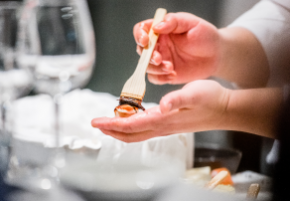- About
- Programs
- Campus Life
- Career Services
- Admissions
- News & Events
- Alumni
How to Ferment Vegetables: Methods, Benefits, and Recipes
Learn how to ferment vegetables using simple methods that enhance flavor and boost health benefits. Discover essential tools, tips, and delicious recipes!
Key Takeaways
- Fermenting vegetables is an ancient, natural method of preservation that's both simple and effective.
- Fermenting vegetables boosts flavor, enhances gut health with probiotics, and increases nutrient absorption.
- Various fermentation methods—like dry salt, brine, kimchi-style, and whey-based—offer flexibility and creative ways to enjoy veggies year-round.
Fermentation is one of the oldest ways of preserving food, dating back thousands of years across cultures. Today, learning how to ferment vegetables has become increasingly popular —not just for the tangy, complex flavors but also for the health benefits it brings. It's also a sustainable way to reduce food waste and eat seasonally.
Popular fermentation methods include dry salt fermentation, brine fermentation, kimchi-style fermentation, and using whey or starter cultures—each offering unique tastes, textures, and techniques you can easily try at home.
How to Ferment Vegetables
Fermenting vegetables is a simple, natural process that turns fresh produce into tangy, probiotic-rich goodness. It all comes down to three essentials: salt, bacteria, and time. Salt draws out moisture and creates a safe environment, allowing beneficial bacteria to take over, break down sugars, and gradually change the flavor and texture over days or weeks.
There are many different vegetable fermentation methods, but they all follow the same magical process of turning fresh veggies into something delicious, gut-friendly, and long-lasting.
Dry salt fermentation
Dry salt fermentation is one of the oldest and simplest ways to preserve vegetables while enhancing flavor and gut health. This method relies on salt to draw out the natural juices from vegetables, creating a brine where good bacteria thrive. It works best for firm vegetables like cabbage, carrots, and radishes. This technique is perfect if you're making classics like sauerkraut or want to ferment without adding water.
How to dry salt ferment:
- Shred or chop your vegetables
- Weigh them and add 2% salt by weight (about one tablespoon per 1.5 pounds or 0.68 kg)
- Massage the vegetables until they release liquid
- Pack tightly into a jar so the brine covers everything
- Weigh them down, cover the jar, and let it ferment at room temperature for 1-3 weeks
Brine fermentation
Brine fermentation is ideal for preserving whole or chopped vegetables in a salty water solution. Instead of drawing out moisture, you create a brine and pour it over the veggies. This method works especially well for cucumbers, green beans, cauliflower, garlic, and peppers. It's a great choice when you want to keep veggies whole or avoid the shredding and mashing step.
How to brine ferment:
- Dissolve non-iodized salt in water (typically 1–3 tablespoons per quart or 0.9L)
- Place the vegetables in a clean jar or crock
- Pour the brine over the vegetables until they are fully submerged
- Add a weight to keep them submerged and cover the container loosely
- Ferment at room temperature for 1–2 weeks, depending on taste
Kimchi-style fermentation
Kimchi-style fermentation adds spice and complexity to your veggie game. It combines dry salting with a flavorful paste made from garlic, ginger, chili flakes, and often fish sauce. This method is best for napa cabbage, daikon radish, carrots, and scallions. It's perfect if you love bold, spicy flavors and enjoy mixing textures.
How to make kimchi-style fermented vegetables:
- Cut the vegetables, salt them, and let them sit for a few hours to soften
- Rinse off excess salt and drain well
- Make a spice paste (garlic, ginger, chili flakes, fish sauce, or soy)
- Mix the paste with veggies and pack tightly into a jar
- Leave some space at the top, seal the jar loosely, and ferment at room temperature for 3-7 days
Whey or starter culture fermentation
This method uses added live cultures—like whey or a powdered starter—to speed up and guide the fermentation process. It's especially handy for soft vegetable mixes like salsa, slaw, or blended sauces. Use this if you want more control over the outcome or need a quicker, more reliable ferment.
How to ferment with starter cultures:
- Chop or blend vegetables (as you would for salsa or slaw)
- Add 1–2 tablespoons of whey or a starter culture per quart (0.9L)
- Mix in a small amount of salt (optional but helpful)
- Pack tightly into a jar, leaving some headspace
- Cover and ferment at room temperature for 2–5 days
Essential Equipment and Ingredients for Fermenting Vegetables
Fermenting vegetables doesn't require fancy equipment, but a few tools can make the process smoother and more reliable. With just a handful of supplies and simple ingredients, you'll be ready to start fermenting confidently at home.
You'll need fermentation jars—wide-mouth glass jars or ceramic crocks work best. Airlocks or breathable lids help release gas while keeping contaminants out. Fermentation weights (glass or ceramic) keep vegetables submerged under brine, and mixing bowls are useful for prepping vegetables with salt.
As for ingredients, always use non-iodized salt like sea salt or kosher salt. Iodine and anti-caking agents can interfere with fermentation. Choose fresh, organic vegetables whenever possible—better ingredients make better ferments. Use clean, chlorine-free water since chlorine can inhibit beneficial bacteria.
Optional ingredients can enhance flavor and fermentation. Spices and herbs like garlic, dill, mustard seeds, or bay leaves add personality to your ferment. A pinch of sugar can help kickstart the process in some cases, while a splash of vinegar is sometimes added for flavor or pH control—just be sure to use it sparingly.
Health Benefits of Fermented Vegetables
Beyond being really delicious, fermented vegetables are packed with health benefits, too. One of the biggest perks is their probiotic content. Probiotics are live bacteria that support a healthy gut. When you eat fermented foods regularly, you help increase the microbiome in your digestive system. This can improve digestion, reduce bloating, and even boost your mood since the gut and brain are closely connected.
Fermentation also improves nutrient absorption. The process breaks down compounds that normally block your body from absorbing minerals like iron and zinc. This makes the nutrients in your vegetables more "available," meaning your body can absorb them more easily. For example, fermented cabbage or carrots will often deliver more usable nutrients than their raw counterparts.
Fermented vegetables also help support a stronger immune system. A healthier gut means a stronger defense against illnesses, and studies have shown that eating fermented foods can reduce inflammation in the body. That's a significant advantage of fermentation since chronic inflammation is linked to many health problems.
Additionally, customizing your ferments with herbs, garlic, or spices adds benefits like antibacterial or anti-inflammatory properties. It's a simple, natural way to eat better and feel better every day.
Best Fermented Vegetable Recipes
Tasty, healthy, and super easy to make at home—here are four beginner-friendly recipes to get you started:
1. Sauerkraut
A classic fermented dish that's crunchy, tangy, and great on sandwiches or as a side.
- Shred one medium cabbage
- Mix with 1-1.5 tbsp non-iodized salt
- Massage until it releases enough liquid
- Pack tightly into a jar, making sure the cabbage stays submerged
- Ferment at room temperature for 1–3 weeks
- Store in the fridge for up to 6 months
2. Traditional pickles
Crispy, garlicky, and full of that signature sour pickle bite.
- Pack cucumbers in a jar with garlic, dill, and spices
- Cover with brine (1 tbsp salt per cup or 16 tablespoons of water)
- Keep the cucumbers submerged with a weight
- Ferment at room temperature for 5–10 days
- Refrigerate once they taste right
3. Fermented garlic honey
Sweet, spicy, and perfect for sore throats or adding flavor to dishes.
- Peel garlic cloves and cover them with raw honey in a jar
- Stir daily for the first week
- Loosely seal and ferment at room temperature for 3–4 weeks
- Store at room temperature—it gets better with time
4. Spicy carrots with ginger and chili
A crunchy, fiery snack or topping with a probiotic kick.
- Slice carrots and mix with grated ginger and sliced chili peppers
- Pack into a jar and cover with brine (2 teaspoons salt per cup or 16 tablespoons of water)
- Ferment for 5–7 days
- Refrigerate once they reach your preferred tang and spice level—they'll keep for months
Transform Your Meals with Fermented Vegetables
Fermenting vegetables is a simple, rewarding way to boost flavor and gut health with just salt, time, and fresh produce. Whether you try sauerkraut, spicy carrots, or garlic honey, each method is beginner-friendly and packed with benefits. Fermentation is all about creativity, so don't be afraid to experiment with different methods and balanced flavors.
If you're passionate about learning about the different kinds of cooking techniques, consider joining the Bachelor of Arts in Culinary Arts or other programs at Culinary Arts Academy Switzerland (CAAS). And if you're interested in plant-based cuisine, you can choose our Swiss Certificate in Vegetarian and Plant-Based Culinary Arts.
CAAS will equip you with the knowledge and technical skills needed to be a renowned chef!
Frequently Asked Questions (FAQs)
How long does it take to ferment vegetables?
Fermentation typically takes 5 to 21 days, depending on the vegetable, method, and room temperature.
Is pickling the same as fermenting?
No. Pickling uses vinegar to preserve while fermenting relies on salt and natural bacteria to create tangy flavors.
What is the difference between lacto-fermentation and fermentation?
Lacto-fermentation is a type of fermentation that uses lactic acid bacteria, whereas fermentation is a broader term that includes processes like alcoholic or yeast fermentation.
Which are the best vegetables for lacto-fermentation?
Cabbage, carrots, cucumbers, radishes, and green beans are ideal for lacto-fermentation due to their texture and sugar content.
Interested in becoming a world-class chef? Learn more about Culinary Arts Academy Switzerland. Download our brochure.




















